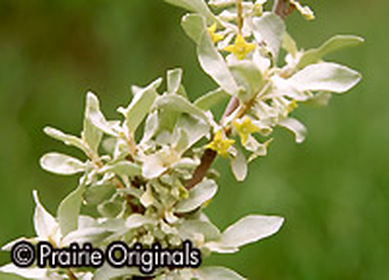Photo Credit By Matt Lavin from Bozeman, Montana, USA (Elaeagnus commutata Uploaded by Tim1357) [CC BY-SA 2.0 (http://creativecommons.org/licenses/by-sa/2.0)], via Wikimedia Commons
"There are moments when the heart is generous, and then it knows that for better or worse our lives are woven together here, one with one another and with the place and all the living things."― Wendell Berry, (Jayber Crow)
 Photo credit www.prairieoriginals.com
Photo credit www.prairieoriginals.com
Elaeagnus Commutata - Wolf Willow - Silverberry
Wolf willow is a North American native shrub related to the Mediterranean olive tree. Wolf Willow is found in a variety of ecosystems including prairie, wetlands and aspen birch stands. It reproduces by rhizomes and seeds. It is an important plant for providing nitrogen for other plants, and for providing food and cover for insects and many animals.
The flowers are very fragrant according to Alberta Plant Watch. Its silvery leaves make it an attractive accent plant in the garden. Like many shrubs in the elaeagnus family, it may be invasive from a vigorous root system. It has the ability to form symbiotic relationships with nitrogen fixing bacteria like Frankia and this benefits surrounding vegetation with natural increased soil nitrogen. Silver berry has been documented to be an excellent companion in orchards increasing fruit yield by ten percent.
The fruit of this plant is a dry silvery berry with a large seed with striped markings. This seed is quite attractive and was use as a bead for necklaces and decorations by First Nations people.The fruit and seed is edible both cooked and raw, so it was used as a food source. The bark was used for weaving and rope making.
Elk and moose eat the plants in wintertime as do many birds. Silverberry is documented to provide 26 percent of the winter diet for populations of moose in Montana. Passerine birds have increased populations in prairie grasslands where there are silverberry shrubs. . The many flowers over a 2 month period in spring and summer provide vital nectar for insects and pollinators such as bees. These plants provide valuable cover for many bird species and small mammals.
This is a wonderful shrub to enhance native bird and pollinator habitat in your garden. Its silvery leaves make it an outstanding and unique accent plant. In a small city yard, is would be best to control its root system with a rhizome barrier. Having appreciation for, and propagating the plants that provide vital habitat for so many other plants, insects and animals in our ecosystem is a wonderful contribution
we can make to protecting the plants of our biome
Jackie Braga
http://practicalplants.org/wiki/Elaeagnus_commutata
http://plantwatch.naturealberta.ca/choose-your-plants/wolf-willow/
http://www.fs.fed.us/database/feis/plants/shrub/elacom/all.html
